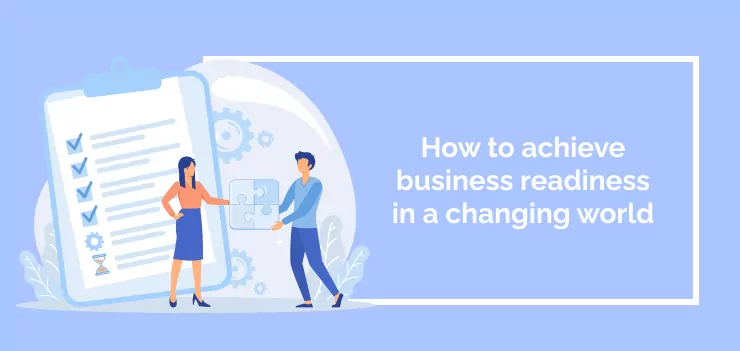
McKinsey says, “To flourish at a time when massive shifts are shaking their organizations, business leaders need to focus on the ‘superpowers’ of speed, technology, talent, and leadership.”
These changes are continuous, often unanticipated, and the only constant in an era marked by disruption.
Whether it embracing the applications of generative AI to augment employee workloads, tackling high rates of employee engagement and turnover in what’s been dubbed “the great resignation,” or adjusting to remote and hybrid working models in response to a global pandemic – the speed at which change is occurring is accelerating fast. Now in high gear.
At the heart of these efforts is a fundamental recognition that change is necessary to progress, grow, and maintain marketplace relevance. Organizations that are unwilling or unable to adapt to evolving macroeconomic conditions hinder organizational development and face the risk of stagnation.
Business readiness is crucial in ensuring that organizations are equipped to handle and embrace change. It involves assessing the company’s current state, identifying gaps, and implementing change management strategies to bridge those gaps, ultimately enabling the company to own and accept the changes that lie ahead.
Doing so sets up the pre-emptive parameters that prepare the workforce for change emanating across not just business environments but also wider global influences.
In this article, we delve into the concept of business readiness and its significance in preparing for an unpredictable world. We’ll explore what business readiness entails, why it’s crucial for organizations, and the key players responsible for preparing a company for change.
Additionally, we’ll discuss the essential prerequisites for achieving business readiness and provide an overview of the business readiness management process, enhancing change capabilities for organisations in an era where change is the only constant.
What is business readiness?
Business readiness can be described as a strategic process that cultivates an organization’s potential to navigate, anticipate, and proactively respond to evolving prospective market conditions, industry trends, and technological advancements.
It involves a holistic approach that goes beyond merely reacting to change; instead, it seeks to embed adaptability and resilience into the very fabric of the organization.
On a more granular level, business readiness management serves as a crucial bridge between business operations and project initiatives. It identifies the essential steps required prior to launching a project or implementing a business strategy and monitors their progress until completion. By acting as an intermediary, business readiness helps to bridge this divide, ensuring seamless collaboration and alignment of objectives.
At the core of business readiness is the recognition that change is inevitable and that organizations must be prepared to embrace it. To achieve this, businesses need to develop a clear vision and mission, supported by well-defined objectives that guide their efforts in addressing challenges and seizing opportunities.
In order to thrive amidst the significant disruptions affecting their organizations, McKinsey emphasizes that “business leaders need to focus on the ‘superpowers’ of speed, technology, talent, and leadership.“
The importance of business readiness?
The significance of business readiness lies in its ability to equip organizations with a unique approach towards embracing change and overcoming challenges.
With the current-state of business operations becoming increasingly complex and unpredictable, the need for change often stems from pressing internal or external factors that demand prompt and effective solutions.
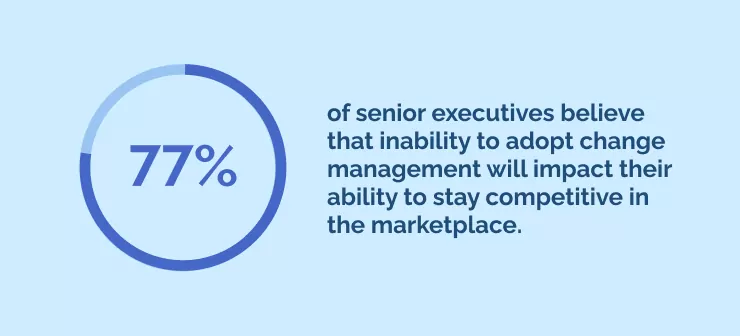
Forbes asserts that “Change capability is the most important missing contemporary for today’s leaders,” which is supported by additional research that shows 77% of senior executives believe that inability to adopt change management will impact their ability to stay competitive in the marketplace.
Business readiness transcends conventional change management by fostering a proactive mindset within organizations. This allows them to anticipate potential obstacles, seize emerging opportunities, and cultivate a culture of innovation and adaptability. By prioritizing business readiness, companies can strengthen their resilience and demonstrate agility in the face of disruptions, strengthening their ability to navigate change.
Who helps the organization prepare for change?
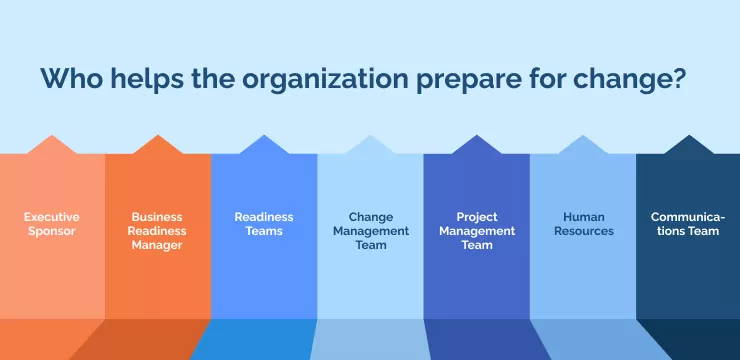
In order to prepare an organization for change and achieve business readiness, several key roles and responsibilities must be assigned. These individuals work collaboratively to ensure a smooth transition and effective implementation of new initiatives. The primary players involved in the business readiness process include:
- Executive Sponsor: This individual is typically a high-ranking executive who champions the change initiative, provides strategic direction, and ensures that necessary resources are allocated for a successful transition.
- Business Readiness Manager: The Business Readiness Manager oversees the entire readiness process, coordinating efforts among various teams, monitoring progress, and ensuring that all prerequisites are met before moving forward with the change initiative.
- Readiness Teams: Comprised of representatives from different departments, these teams play a crucial role in identifying potential challenges, developing solutions, and facilitating communication across the organization. They may consist of subject matter experts, process owners, and frontline employees who have a deep understanding of the impacted areas.
- Change Management Team: This team is responsible for planning and executing the change management strategy, which includes providing training, addressing employee concerns, and monitoring the adoption of new processes and systems.
- Project Management Team: Tasked with overseeing the technical aspects of the change initiative, this team ensures that projects are delivered on time, within budget, and aligned with the organization’s strategic objectives. A Gartner survey reveals that nearly 70% of PMO and PPM leaders think the volume, frequency, and complexity of change have grown compared to three years ago.
- Human Resources: HR plays a vital role in supporting employees throughout the change process, providing guidance on workforce planning, talent development, and performance management.
- Communications Team: Effective communication is essential during times of change, and this team is responsible for crafting clear and consistent messaging that keeps all stakeholders informed and engaged throughout the transition.
By identifying and assigning these key roles and responsibilities, organizations can establish a well-rounded support system that enables them to successfully navigate change and achieve business readiness.
Prerequisites for business readiness
To achieve business readiness, organizations must create a supportive environment that embraces change and promotes growth. This involves fostering transparency through open communication, which keeps everyone informed about upcoming changes and their potential impact. By doing so, employees feel included in the decision-making process and are better prepared to adapt.
A flexible approach is also essential for success, as it allows organizations to adjust their strategies and processes in response to evolving circumstances. This adaptability ensures that businesses remain resilient and can quickly respond to new challenges or opportunities.
Strong leadership plays a crucial role in guiding teams through change by providing direction, support, and motivation. Effective leaders help employees navigate transitions confidently, maintaining focus on the organization’s objectives during periods of change.
The Harvard Business Review sheds light on the current-state of organizational leadership, sharing, “Despite the vast body of knowledge available to leaders on how to effect lasting, positive organizational change, too many executives continue reaching for the same comfortable levers that consistently miss the mark.”
Investing in employee training and development is vital for equipping the workforce with the necessary skills and knowledge to adapt to change. According to Lorman data, approximately 59% of employees assert that they received no workplace training, relying mostly on self-taught skills.
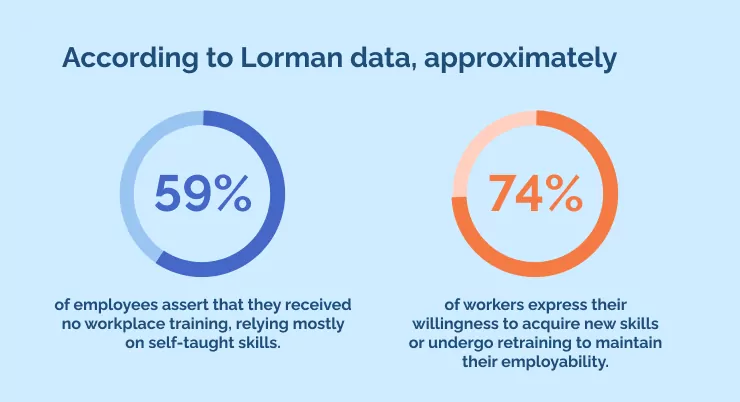
Furthermore, 74% of workers express their willingness to acquire new skills or undergo retraining to maintain their employability. By providing the right tools, organizations can ensure their employees succeed in a constantly changing environment.
Implementing effective change management strategies is key to minimizing disruption and maximizing the benefits of new initiatives. A structured approach to managing change ensures smoother transitions and better adaptation to new situations. One-third of CEOs didn’t attain their goals from past transformation projects, while employee burnout affects two-thirds, further hindering transformation success.
Finally, cultivating a culture of innovation is essential for organizations to remain agile and responsive. By encouraging creativity and out-of-the-box thinking, businesses can better prepare themselves for new challenges and capitalize on new opportunities.
Business readiness management process
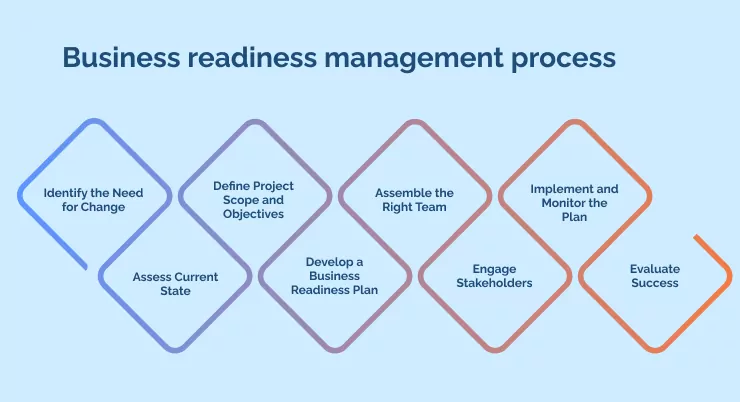
Throughout this article, we have underscored the significance of business readiness as a systematic approach that prepares organizations for change and ensures the success of new projects.
Now, let’s delve deeper into the business readiness management process. By following these crucial steps prior to launching a project, companies can effectively reduce risks, streamline implementation, and enhance the likelihood of meeting their objectives.
- Identify the Need for Change: Begin by pinpointing the factors driving the need for change, such as market shifts, competitive pressures, or internal inefficiencies. Clearly articulate the rationale behind the proposed project and establish its strategic relevance to the organization’s overall objectives.
- Assess Current State: Conduct a comprehensive evaluation of the organization’s existing processes, systems, and capabilities to identify areas requiring improvement or adaptation. This assessment should include an analysis of potential risks, resource requirements, and the impact of change on various stakeholders. Conducting a SWOT analysis is a great strategic method to identify an organisation’s competitive advantages, uncover areas for improvement, and illuminate potential opportunities and challenges.
- Define Project Scope and Objectives: Establish the project’s scope by outlining its specific goals, deliverables, and boundaries. Clearly define the desired outcomes and success criteria, ensuring that they are measurable, achievable, and aligned with the organization’s strategic vision.
- Develop a Business Readiness Plan: Create a detailed plan that outlines the necessary steps, resources, and timelines for achieving business readiness. This plan should encompass aspects such as stakeholder engagement, communication strategies, change management initiatives, and employee training and support.
- Assemble the Right Team: Identify and recruit individuals with the requisite skills, expertise, and experience to successfully execute the project. Form cross-functional teams, including representatives from impacted departments, to foster collaboration and ensure a holistic approach to change.
- Engage Stakeholders: Actively involve key stakeholders in the planning and decision-making process, soliciting their input and addressing any concerns or apprehensions. Effective stakeholder engagement fosters buy-in and commitment to the project, enhancing the likelihood of successful adoption and implementation.
- Implement and Monitor the Plan: Execute the business readiness plan, continuously monitoring progress and adjusting the approach as necessary to address emerging challenges or capitalize on unforeseen opportunities. Regularly communicate updates to stakeholders, ensuring transparency and maintaining momentum throughout the project lifecycle.
- Evaluate Success: Upon project completion, assess the extent to which the desired outcomes and success criteria have been achieved. Conduct a post-implementation review to identify lessons learned, celebrate successes, and apply insights to future initiatives.
By adhering to this business readiness management process, organizations can effectively prepare themselves for change, fostering an environment conducive to the successful launch and execution of new projects.
Embracing change for business readiness
In conclusion, business readiness transcends merely preparing for change; it involves nurturing resilience, fostering collaboration, and empowering employees to become catalysts of transformation within the organization. If a company is not prepared for change, it risks falling behind or even becoming obsolete.
As we move forward in a world still grappling with the impacts of COVID-19, the need for business readiness takes on even greater significance.This unprecedented situation has demonstrated that organizations must be agile, adaptive, and ready to face unforeseen challenges head-on.
In addition, macroeconomic and geopolitical tensions fuelled by the Russian invasion of Ukraine are adding complexity to the mix, making it crucial for executive decision-makers to be proactive in their approach in becoming business ready.
“In rather breathtaking speed the pandemic has upended things like you say, pushing our planning horizons it seems almost to nothing. We’re flying blind into some very, very uncertain future that’s out there,” says former US defence secretary General James Mattis
WalkMe Team
WalkMe spearheaded the Digital Adoption Platform (DAP) for associations to use the maximum capacity of their advanced resources. Utilizing man-made consciousness, AI, and context-oriented direction, WalkMe adds a powerful UI layer to raise the computerized proficiency, everything being equal.



